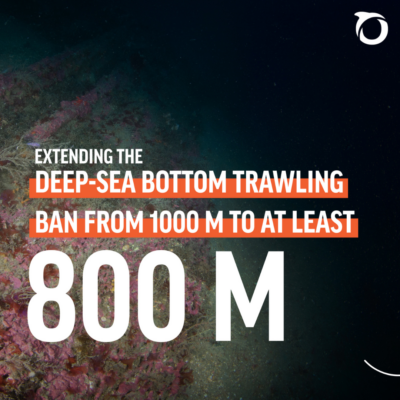The Mediterranean
The Mediterranean is a biodiversity hotspot. By volume, its waters are just 0.32% of the world’s ocean, but it is home to between 4% and 18% of known marine species. The Med is at risk. The populations of many groups of species have registered sharp declines in recent decades, including top predators such as sharks, rays, and marine mammals. It is a semi-enclosed, heavily populated region, and one of the most polluted seas in the world by plastic. Oceana has campaigned in the Mediterranean since the creation of Oceana’s office in Europe in 2003.
The Mediterranean deep-sea
The Mediterranean Sea has an average depth of 1,500 metres and is divided into the Western, Central, and Eastern basins, with the Strait of Sicily marking the main divide. Its deep-sea ecosystems are rich in biodiversity, potentially supporting up to 3,000 species out of the 17,000 found across the entire sea. Oceana is calling for a ban on bottom trawling below 800 metres in the Mediterranean to protect Vulnerable Marine Ecosystems (VMEs)—fragile biodiversity hotspots that often serve as crucial feeding, spawning, or nursery grounds for marine life.
Scientific studies have shown the harmful impacts of fishing on deep-sea ecosystems, and the many benefits of banning bottom trawling in deep-sea areas, including:
- More protection for vulnerable marine ecosystems
- Improved carbon storage
- Less pressure on overfished stocks
- Same fishing rules as in the EU Atlantic
Some countries have already taken steps towards banning bottom trawling below 800m depth. In May 2024, Spain banned bottom trawling in national Spanish waters below 800 m and its fleet from bottom trawling below 800 m in all the Mediterranean.
This measure was adopted in the context of the implementation of the EU Western Mediterranean Multiannual Plan (WestMedMAP) and was accompanied by the granting of additional fishing days to the Spanish fleet as a compensation measure. However, this could increase significantly the number of fishing days for shallower areas, with potential risks for the sustainability of other fisheries.
Overfishing in the Mediterranean
Overfishing continues to plague the Mediterranean Sea, with 57% of fish stocks currently overexploited—including popular species like hake and blue and red shrimps. According to Oceana’s research, fishing below 800 metres in the Mediterranean is relatively limited and primarily targets deep-sea shrimp. These shrimp stocks are already overfished in nearly all areas managed by the General Fisheries Commission for the Mediterranean (GFCM). Oceana’s data identify Spain, Italy, Malta, and Cyprus as the main flag states for deep-sea fleets operating in the region. However, limited data on non-EU fleets—some of which are known to fish below 800 metres, prevents a complete assessment of their activities.
Protecting Cabliers
Until recently, the Cabliers Bank was a hidden jewel in the Mediterranean Sea, the reef was discovered by Oceana and is the only cold-water coral reef known to be growing in the Mediterranean. This underwater biodiversity treasure has survived throughout centuries and is a unique deep-sea biodiversity hotspot located in the Alboran Sea (the westernmost part of the Mediterranean) between Spain, Morocco and Algeria. Oceana is advocating for the protection of the Cabliers Bank, a unique place to protect!







